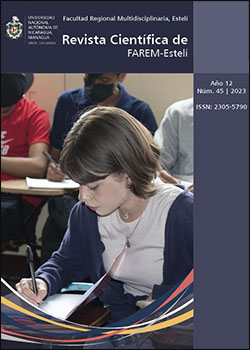Design and Evaluation of a Pilot-Scale Permeable Reactive Barrier System for Nitrate Load Reduction in Agricultural Surface Runoff Water
DOI:
https://doi.org/10.5377/farem.v12i45.16048Keywords:
Permeable reactive barriers, denitrification, nitrates, removal of nitratesAbstract
The need to increase food security has led to the over-application of synthetic fertilizers. Nitrate is a highly mobile fertilizer in soils, so when it comes into contact with a body of water, it can initiate a process of eutrophication by over-enriching it, as well as cause a disease known as methemoglobinemia. The objective of the present research was to design and evaluate a permeable reactive barrier to remove nitrates in agricultural surface runoff water. This research has a pilot type scope, at laboratory scale and applied since the results will solve an identified problem, of exploratory cut from the point of view of the depth of the research, because it deals with a new field in Nicaragua. For this purpose, two permeable reactive barriers were built with dimensions of 1.0-meter-long, 0.5 m wide and 0.5 m deep, profiled in CIRA/UNAN-Managua. The first was filled with soil from the site, the second with a mixture of soil plus a substrate (previously selected). The system was fed with a mixture of 100 mg/l of nitrates from a commercial synthetic fertilizer (FORMUNICA, NH4NO3). As a carbon source, sawdust was used for the development of denitrifying bacteria. Samples were taken at the outlet of the system on days 0, 7, 9, 12, 15 and 19, for subsequent analysis of the nitrates present. The removal efficiency of the system was 55% for the control bed and 66% for the denitrifying bed. It is important to highlight the findings related to the operation of the Barriers from the physical point of view, since this technology is a low-cost alternative, easy to build, maintain and manage, with efficient results for nitrate removal.
Downloads
References
Bednarek, A., Szklarek, S., & Zalewski, M. (2014). Nitrogen pollution removal from areas of intensive farming. Revista, 1-10. Lodz, Banacha, Polonia.
Diagnóstico de la calidad del agua de consumo en las comunidades del sector ruralGonzales, O., Aguirre, J., Orozco, G., & Palacio, K. (2007). Diagnóstico de la calidad del agua de consumo en las comunidades del sector rural. Nicaragua.
Environmental Management Support, Inc., Silver Spring, MD.;Environmental Protection Agency, Washington, DC. Office of Solid Waste and Emergency Response. (1999). Field applications of in situ remediation technologies : permeable reactive barriers. Ada, Ok, U.S.A.
EPA. (1998). Permeable reactive barrier technologies for contaminant remediation. Informe EPA 600-R-98-125. Washington, U.S.A.
Hochstrat, R., Wintgens, T., Melin, T., & Jeffrey, P. (2005). Wastewater reclamation and reuse in Europe: a model-based potential estimation,Water Supply.
MMA. (2000). Libro Blanco del agua en España. Madrid, España.
Naciones Unidas. (2015). Objetivos de Desarrollo Sostenible 2030. Obtenido de https://www.un.org/sustainabledevelopment/es/water-and-sanitation/
Normas CAPRE. (2020). Rasnic.org. Obtenido de https://www.rasnic.org/wp-content/uploads/2020/09/CAPRE_Normas_Regional-1.pdf
Rittman, B. E., & Macarty, P. L. (2001). Biotecnología del Medio Ambiente:. (McGraw-Hill, Ed.) Madrid, España.
Sampieri, R. H. (2014). Metodología de la Investigación. D.F, Mexico: McGRAW-HILL.
ugr.es. (1999). Nitrifcación. Importancia Ambiental. España.
Yuanyuan , L., Haiyan, M., Liqun, C., Zakaria, A., & Li, L. (2015). Cr(VI)-contaminated groundwater remediation with simulated permeable reactive barrier (PRB) filled with natural pyrite as reactive materi. Environmental factors and effectiveness,. Chongqing , RP. China.
Published
How to Cite
Issue
Section
License
Copyright (c) 2023 Revista Científica de FAREM-Esteli

This work is licensed under a Creative Commons Attribution-NonCommercial-ShareAlike 4.0 International License.

